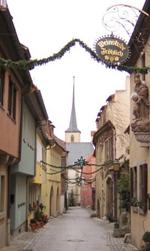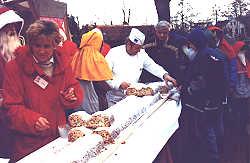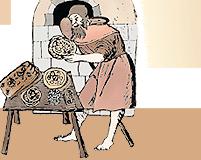 My mother just baked twelve Christstollen for Christmas. It’s unthinkable to be without it. Christstollen is a traditional Christmas cake in Germany, also referred to as Christbrot or Striezel, and was first heard of in 1329 in Saxony. This cake is also one of the "form breads" since the loaf with the powdered sugar is to resemble the swaddling clothes of Baby Jesus.
My mother just baked twelve Christstollen for Christmas. It’s unthinkable to be without it. Christstollen is a traditional Christmas cake in Germany, also referred to as Christbrot or Striezel, and was first heard of in 1329 in Saxony. This cake is also one of the "form breads" since the loaf with the powdered sugar is to resemble the swaddling clothes of Baby Jesus.
 Since the time before Christmas is Advent season, which is a fasting time, the dogma of the church did not allow bread to be baked with butter. Only oil, water, and flour were to be used. This made for a tasteless cake. The electors of Dresden, Ernst and Albrecht von Sachsen were not too fond of the taste either, and made a written request to Pope Nikolaus V in 1450 to ease the fasting laws and to allow the use of butter. It was not until 1491 that Pope Innocence VIII reduced the law to allow some fattening taste in the Christstollen.
Since the time before Christmas is Advent season, which is a fasting time, the dogma of the church did not allow bread to be baked with butter. Only oil, water, and flour were to be used. This made for a tasteless cake. The electors of Dresden, Ernst and Albrecht von Sachsen were not too fond of the taste either, and made a written request to Pope Nikolaus V in 1450 to ease the fasting laws and to allow the use of butter. It was not until 1491 that Pope Innocence VIII reduced the law to allow some fattening taste in the Christstollen.
German cities are busy with Kristkindl Markets during the Christmas season. One of the oldest markets, called the Striezelmarkt, is also located in Dresden. Its name derived from this famous Christmas cake.
 In 1434 Friedrich II gave permission for a free meat market to be held once a week and on Christmas Eve. The market became so successful that privileges were extended to sell other goods. This included baked goods, pottery, goods of the goldsmith and glass blowers, as well as fine linens and lace. Wood carved items, such as toys, are an all time favorite with children and adults. Part of the Christmas décor in Germany is still the famous wooden ornaments of angels and nutcrackers and of St. Nicklaus.
In 1434 Friedrich II gave permission for a free meat market to be held once a week and on Christmas Eve. The market became so successful that privileges were extended to sell other goods. This included baked goods, pottery, goods of the goldsmith and glass blowers, as well as fine linens and lace. Wood carved items, such as toys, are an all time favorite with children and adults. Part of the Christmas décor in Germany is still the famous wooden ornaments of angels and nutcrackers and of St. Nicklaus.
As the market flourished, traders were permitted to rent carts to offer their goods. In 1624 the market became so successful that neighboring businesses and tradesmen felt its competition and requested that the city council intervene by restricting the market. However, the city council denied the request. The result of this wise decision led to expanding the wares to be sold so that they included crafts and goods throughout Saxony.
 It is noted in the city archives that in 1560 the council members were invited by the mayor of the city of Dresden for a Stollenessen. Until the 17th Century every council member received a Christstollen during the Christmas season from the city as an act of generosity.
It is noted in the city archives that in 1560 the council members were invited by the mayor of the city of Dresden for a Stollenessen. Until the 17th Century every council member received a Christstollen during the Christmas season from the city as an act of generosity.
Dresdner master bakers had to pay a tributary to the chief head of the Wettiner. Traditionally, on the day after Christmas eight master and fellow bakers took the king a Christstollen that weighed 36 pounds and was one and a half meters long. The tradition continued until the monarchy ended in 1918.
 Most Christmas markets in Germany are still very much a time of eating and drinking, with many craftsmen and traders offering their goods with lots of sweets. The place is filled with the smells of spices that come from the Far East.
Most Christmas markets in Germany are still very much a time of eating and drinking, with many craftsmen and traders offering their goods with lots of sweets. The place is filled with the smells of spices that come from the Far East.
One of the most desired drinks at the markets is hot Gluehwein (mulled wine) made out of red wine, cinnamon sticks, cloves and oranges. Its spicy aroma and alcoholic content will warm up any visitor when walking through the markets in freezing temperatures.
 Also quite interesting is the Lebkuchen, which resembles a small round spice cake. Since it was seen as a fasting cake, it could not be made with yeast. Hirschhornsalz (hartshorn) was used to raise the dough and was mixed with oriental spices such as cinnamon, cloves, anis and honey for flavoring.
Also quite interesting is the Lebkuchen, which resembles a small round spice cake. Since it was seen as a fasting cake, it could not be made with yeast. Hirschhornsalz (hartshorn) was used to raise the dough and was mixed with oriental spices such as cinnamon, cloves, anis and honey for flavoring.
 It made its first appearance in Franconian monasteries, and by 1296 was also noted in the city of Ulm. Starting in the 14th Century, this little spiced cake became quite famous in Nürnberg. The cakes can be covered with almonds, chocolate or sugar frostings, and taste very delicious with a steaming cup of coffee. Although considered a fasting cake for the Advent season, it was served with strong beer centuries ago.
It made its first appearance in Franconian monasteries, and by 1296 was also noted in the city of Ulm. Starting in the 14th Century, this little spiced cake became quite famous in Nürnberg. The cakes can be covered with almonds, chocolate or sugar frostings, and taste very delicious with a steaming cup of coffee. Although considered a fasting cake for the Advent season, it was served with strong beer centuries ago.
 The wintry weather will not keep visitors and carolers away. Christmas markets would not be complete without music and song. Sounds of "Oh Du Frhliche" and "Ihr Kinderlei Kommet" are some of the older Christmas melodies I remember from childhood. It is a magical time for children with all the lights and music and games.
The wintry weather will not keep visitors and carolers away. Christmas markets would not be complete without music and song. Sounds of "Oh Du Frhliche" and "Ihr Kinderlei Kommet" are some of the older Christmas melodies I remember from childhood. It is a magical time for children with all the lights and music and games.
Strikingly, the popularity of cakes and markets during the Christmas Season became famous in strong trading cities, such as Nürnberg, Hamburg and Dresden. Ingredients that are needed to make these traditional Christmas goods all come from foreign lands and require the import and distribution of these spices. To this day, Christstollen and Lebkuchen are two of the dominant bakery goods that sweeten the Christmas season. Our famous Kirstkindl markets last to this day and are a reminder how long lasting a good idea can be.



